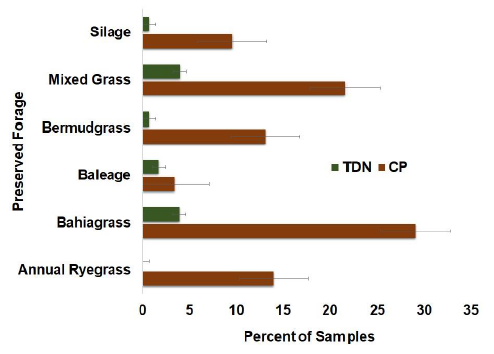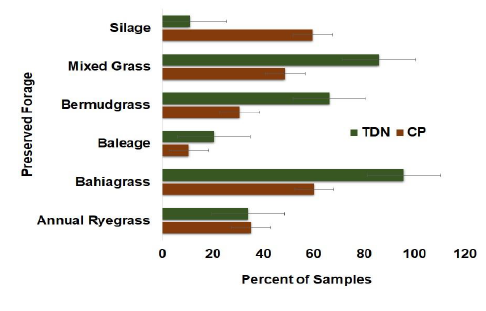Hay Testing: The Road Map to Developing an Efficient Supplementation
Authors
Extension/Research Professor
Forage Establishment, Grazing Systems and Management, Hay Production, Forage Fertility, Forage Quali
The recommended way to take a hay sample is using a hay probe. A composite sample should always be collected from the entire lot. A lot means hay that was harvested and stored under the same conditions. The first, second, third cut, etc. are usually considered a lot. If the second cut was harvested and half of the field was baled before the rain and the other half was baled three days after the rain, then those will be considered two different hay lots due to the environmental conditions. When collecting a hay sample, it is recommended to take sub-samples from around 10 percent of the total bales in the bales by coring at 18 to 24 inches into the bale. Hand grabs of hay are recommended because they do not represent the composition of the bale or the lot from the type of bale they were collected. Hay samples should be collected at least two weeks after post-baling, but the best time to sample is close to feeding time (at least four weeks). In the case of baleage/haylage, samples should be collected at least 35 days post-ensiling to ensure proper fermentation.
To obtain a complete nutrient analysis of the composite hay sample, a producer needs to submit a hay sample to a certified laboratory such as the Mississippi State Chemical State Laboratory or a commercial laboratory. It is important to provide as much information as possible in the submission form, to make sure that the lab is using the correct analysis for the sample. The accuracy of your sample depends largely on the sampling method and lab technique. Always send a sample that is certified by the National Forage Testing Association when submitting a hay sample. A hay analysis will also allow the cost per pound of nutrient but also help in determining the price for different commodity feeds and supplements (Fig. 1 & 2). Data obtained from the analysis can be input into the Mississippi State Hay Calculator to determine deficiencies in nutritive value (https://bit.ly/MSStateHayCalculator).
Hay nutritive value is always important in livestock nutrition and can greatly affect the cost of supplementation. Remember that not all hay is created equal and there is a significant variation in nutrient content within a particular type of forage species based on maturity, fertilization, temperature, and conditions at harvesting and baling. When using hay produced on the farm or purchasing hay, a feeding program should be developed based on individual livestock requirements. Proper ration balancing beings with hay testing; know what you are feeding.


Sheep and Goat Production Webinar Series (6:00 PM to 7:00 PM CST)
Registration Required
November 2, 2021— Proper Feeding for Breeding, Pregnancy, and Lactation
November 16, 2021— Sustainable Parasite Control
November 30, 2021— McMaster and Parasite Identification from Fecal Samples
For upcoming forage related events visit: http://forages.pss.msstate.edu/events.html